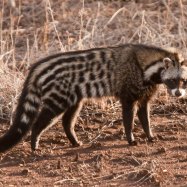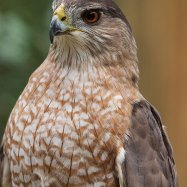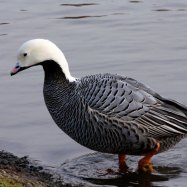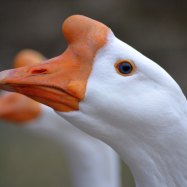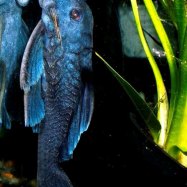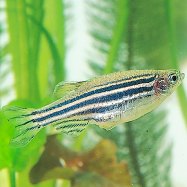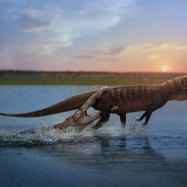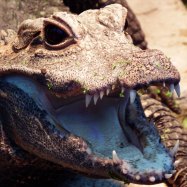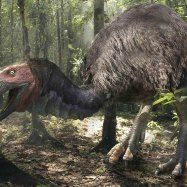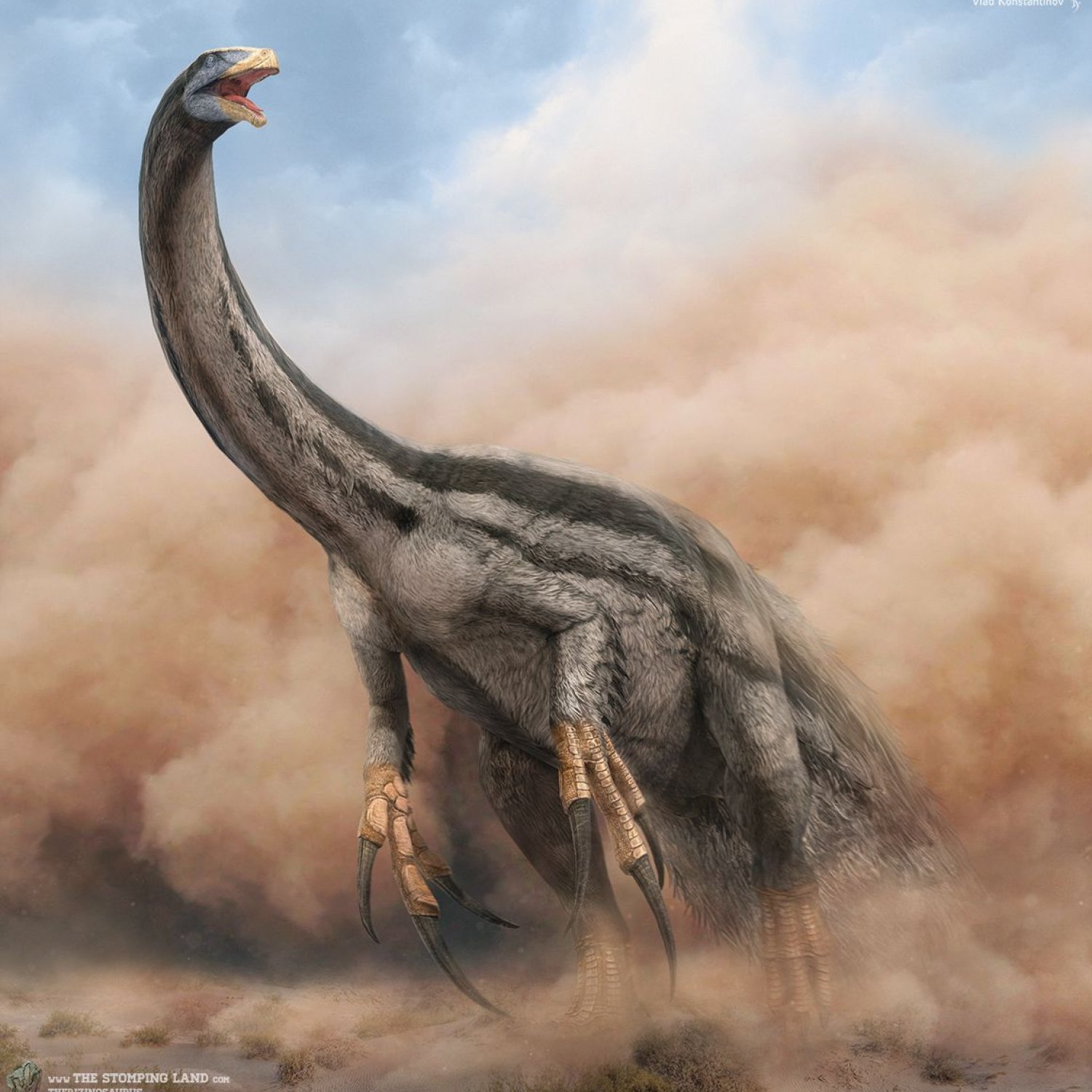
Therizinosaurus
8-10 meters
Therizinosaurus was a majestic creature that roamed the Gobi Desert during the Cretaceous period. This herbivorous dinosaur was a part of the Therizinosauridae family and had a body shape that was both large and bulky. Measuring 8-10 meters in length, it was a sight to behold. Its name translates to scythe lizard due to its long, curved claws. Though it has since gone extinct, its legacy lives on through fossils and scientific research. #Therizinosaurus #GobiDesert #DinosaurFacts
Animal Details Summary:
Common Name: Therizinosaurus
Kingdom: Animalia
Habitat: Terrestrial
The Enigmatic Therizinosaurus: Unraveling the Mysteries of the Gobi Desert's Iconic Herbivore
Deep in the heart of the Gobi Desert, a land known for its harsh and unforgiving conditions, lies a creature shrouded in mystery and fascination – the Therizinosaurus. With its long, razor-sharp claws and perplexing herbivorous diet, this enigmatic creature has captivated the minds of scientists and the general public alike since its discovery in the 1950s. From its unique physical features to its elusive behavior, the Therizinosaurus continues to puzzle researchers and spark our imagination. Let's dive into the intriguing world of this prehistoric giant and uncover the truths behind its existence Therizinosaurus.A Brief Introduction to Therizinosaurus
Scientifically known as Therizinosaurus cheloniformis, this dinosaur belongs to a group called the therizinosaurs, a branch of theropod dinosaurs. But unlike its carnivorous relatives such as the famous Tyrannosaurus Rex or Velociraptor, Therizinosaurus was a herbivore. Its name, which means “scythe lizard,” is derived from its most distinctive feature – its long and curved claws, shaped like sickles.Therizinosaurus lived in the Cretaceous Period, approximately 70 million years ago, in what we now know as Mongolia and China. Despite its large size of 8-10 meters, very little is known about this gentle giant, and much of what we do know is based on limited skeletal remains. However, recent discoveries have shed more light on this elusive creature, leading to some exciting revelations.
The Physical Characteristics of Therizinosaurus
One of the most striking features of the Therizinosaurus is its unique physical appearance. With its long neck, small head, and bulky body, it resembled a cross between a giraffe and a bear. But what really sets it apart are its formidable claws Timber Rattlesnake.These claws were thought to be almost a meter long, making them the longest claws among any known animal. The overall shape of the claws is curved, similar to that of a sickle, but with a blunt tip. This has led to much speculation about their use, with some suggesting that they were used for defense while others believe they were used for foraging.
Therizinosaurus also had a large and deep chest cavity, suggesting that it had a powerful respiratory system. This adaptation allowed it to maintain a constant body temperature, an essential trait for a creature living in a harsh environment like the Gobi Desert.
Unraveling the Mystery Behind the Claws
The purpose of Therizinosaurus' claws is a topic that has intrigued researchers for decades. After all, how can a herbivore have such sharp and formidable claws? Several hypotheses have been proposed, with the most widely accepted one being the use of the claws for foraging.Recent studies have shown that the size and shape of the claws were ideal for stripping leaves and branches from trees. In addition, the presence of ridges on the underside of the claws suggested that they were used for grasping and holding onto branches. This unique foraging behavior is unlike any other known dinosaur and has only been seen in modern-day animals such as the tree-climbing sloths.
The discovery of a complete skeleton of a juvenile Therizinosaurus further supported the foraging hypothesis. The claws on this specimen were smaller and less curved, suggesting that the dinosaurs' claws were modified as they aged and their diet changed.
The Enigmatic Diet of Therizinosaurus
The idea of a herbivorous dinosaur with sharp claws may seem contradictory, but that is what makes Therizinosaurus such a fascinating creature. The primary evidence for its herbivorous diet comes from the wear and tear on its teeth, which indicate it fed on tough, fibrous plant matter such as leaves and branches.However, it has also been suggested that Therizinosaurus is a prime example of an omnivorous dinosaur, with its large and powerful beak-like mouth capable of crushing hard-shelled fruits and nuts. This theory is further supported by the dental structure of its close relatives, which showed signs of a mixed diet.
The Mystery of the Therizinosaurus Family
Aside from its peculiar physical appearance and diet, very little is known about the life cycle and behavior of Therizinosaurus. The lack of complete skeletons has made it challenging to determine its family structure, such as whether they lived in herds or were solitary creatures. However, one unique find may give us some insight into their behavior.In 2008, a group of three Therizinosaurus skeletons were discovered buried together in Mongolia. This is the first evidence of social behavior among these dinosaurs, suggesting that they may have lived in small groups or herds. This find has led to further exploration, with a recent discovery of a possible nesting site indicating that Therizinosaurus may have exhibited parental care.
The Impact of Therizinosaurus on Evolution
The discovery of Therizinosaurus has had a significant impact on the field of paleontology. Its unique physical features and feeding method have led researchers to re-evaluate their understanding of dinosaurs and their evolution.Therizinosaurus also shares many traits with modern-day birds, such as hollow bones, a long neck, and beak-like mouth, leading to the hypothesis that birds evolved from theropod dinosaurs. This connection has opened up a new world of possibilities for research and understanding the evolutionary history of these fascinating creatures.
In Conclusion
The Therizinosaurus may be a dinosaur that has faded into obscurity due to a lack of complete fossils, but developments in recent years have reignited interest in this mysterious creature. From its unique physical features to its enigmatic diet and behavior, Therizinosaurus continues to surprise and fascinate researchers and the general public alike. As more fossils are discovered and new theories emerge, the Therizinosaurus is destined to remain an enigma of the prehistoric world, captivating us with its mystery and leaving us to ponder – what other secrets does the Gobi Desert hold?

Therizinosaurus
Animal Details Therizinosaurus - Scientific Name: Therizinosaurus cheloniformis
- Category: Animals T
- Scientific Name: Therizinosaurus cheloniformis
- Common Name: Therizinosaurus
- Kingdom: Animalia
- Phylum: Chordata
- Class: Sauropsida
- Order: Therizinosauroidea
- Family: Therizinosauridae
- Habitat: Terrestrial
- Feeding Method: Herbivorous
- Geographical Distribution: Asia
- Country of Origin: Mongolia, China
- Location: Gobi Desert
- Animal Coloration: Unknown
- Body Shape: Large and bulky
- Length: 8-10 meters
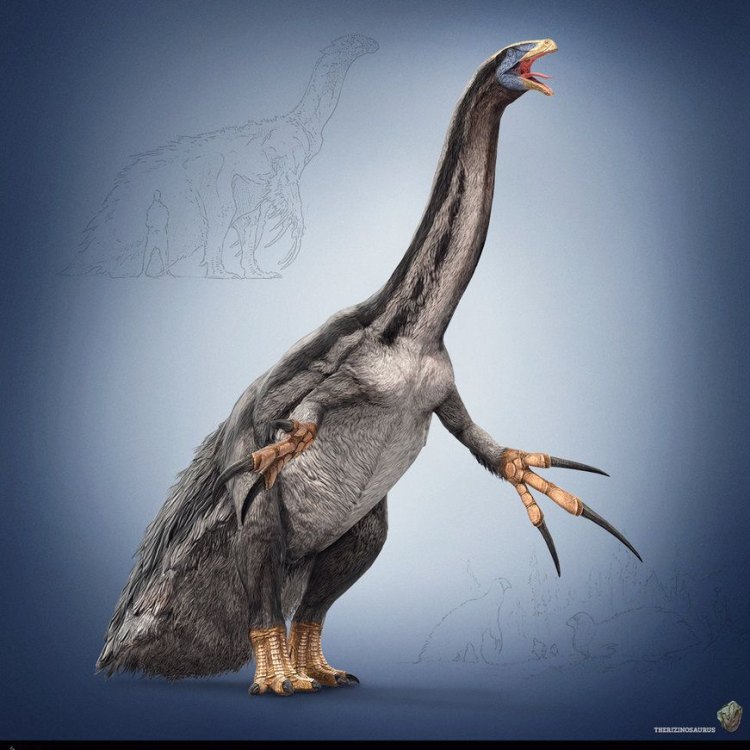
Therizinosaurus
- Adult Size: Very large
- Average Lifespan: Unknown
- Reproduction: Egg-laying
- Reproductive Behavior: Unknown
- Sound or Call: Unknown
- Migration Pattern: Unknown
- Social Groups: Unknown
- Behavior: Unknown
- Threats: Unknown
- Conservation Status: Extinct
- Impact on Ecosystem: Unknown
- Human Use: None
- Distinctive Features: Long neck, long claws
- Interesting Facts: Therizinosaurus had the longest claws of any known dinosaur.
- Predator: Unknown
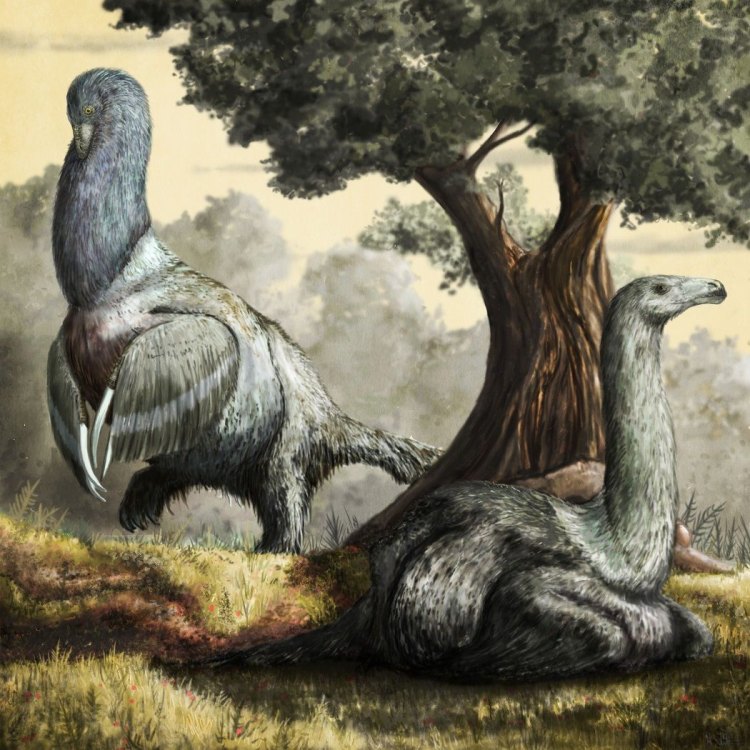
Therizinosaurus cheloniformis
The Mysterious Therizinosaurus: Uncovering the Secrets of the Long-Clawed Giant
When one thinks of dinosaurs, the image of a ferocious T-Rex or a towering Brachiosaurus often comes to mind. However, there were also some lesser-known species that roamed the Earth millions of years ago, and one of the most mysterious of them all is the Therizinosaurus. This enigmatic creature is a large, herbivorous theropod dinosaur that lived during the late Cretaceous period, around 70-75 million years ago. It was recently discovered in the 1950s in Mongolia and has since fascinated scientists and dinosaur enthusiasts alike PeaceOfAnimals.Com. Here, we will delve into the unique features and intriguing facts about the Therizinosaurus and try to unveil the mysteries surrounding this ancient creature.Adult Size: Very large
The Therizinosaurus is a prime example of the saying “size doesn’t matter.” While it is easy to assume that this dinosaur was massive due to its theropod classification, it was surprisingly not. With an average weight of 3 to 5 tons, the Therizinosaurus was significantly smaller than some of its contemporaries. However, what it lacked in size, it made up for in its distinctive features.
Distinctive Features: Long neck, long claws
The Therizinosaurus had a unique appearance that set it apart from other dinosaurs. Its long, slender neck gave it a graceful look, while its large body was supported by four sturdy legs. But what made it stand out the most were its long, sharp claws. These claws were its most remarkable and defining feature, measuring up to 3 feet in length Texas Spiny Lizard. These long claws were unlike any other dinosaur and were the longest known claws of any dinosaur species.
Interesting Facts: Therizinosaurus had the longest claws of any known dinosaur.
No other dinosaur has been found to have such long claws as the Therizinosaurus. These claws were not just for show, as they were incredibly sharp and could inflict a considerable amount of damage. They were also used for defensive purposes, as this herbivorous dinosaur may have needed protection from predators.
Behavior and Social Groups: Unknown
Unfortunately, not much is known about the behavior and social groups of the Therizinosaurus. Due to its recent discovery and limited fossil remains, scientists have not been able to determine its social structure or behavior. However, one thing that is hypothesized is that it was a solitary animal, mainly due to its relatively small size for a theropod.
Reproduction and Reproductive Behavior: Unknown
Like many aspects of the Therizinosaurus, its reproductive behavior remains a mystery. It is not known how these dinosaurs courted, mated, or raised their offspring. As with behavior and social groups, the lack of fossil evidence makes it challenging to determine these aspects of their lives.
Predator: Unknown
Being an herbivore, it is assumed that the Therizinosaurus had no predators and lived peacefully among its fellow herbivores. However, since there is a lack of information on its behavior and social structure, it is also possible that it may have been preyed upon by larger carnivorous dinosaurs.
Threats: Unknown
Similar to its predators, the specific threats that the Therizinosaurus faced are unknown. It is possible that due to its large size and sharp claws, it may not have had many predators. However, environmental factors such as natural disasters or changes in climate may have posed a threat.
Migration Pattern: Unknown
Without much information on its behavior and social structure, it is impossible to determine the migration patterns of the Therizinosaurus. It is possible that they migrated in search of food or water, but again, this is merely speculation.
Sound or Call: Unknown
One can only imagine the sounds that this unique dinosaur may have made. Unfortunately, no evidence of a sound or call of the Therizinosaurus has been found. It is possible that it made noises similar to other theropod dinosaurs, but this cannot be confirmed.
Human Use: None
Unlike many other dinosaur species, the Therizinosaurus has not been used for human purposes. Its fossils are scarce, and the lack of information on its behavior and characteristics make it challenging for scientists to study and replicate. It remains purely a scientific fascination and has not been used for human gain in any way.
Impact on Ecosystem: Unknown
The Therizinosaurus was a herbivore, which means that it played an essential role in maintaining balance in the prehistoric ecosystem. Its diet consisted of leaves, fruits, and other vegetation, and its large size may have acted as a natural lawnmower, keeping the vegetation in check. However, without sufficient evidence, the exact impact of this dinosaur on the ecosystem remains unknown.
Average Lifespan: Unknown
The lifespan of the Therizinosaurus is also a mystery, mainly due to the rarity of fossil remains. However, it is estimated that they could have lived anywhere between 30 and 50 years. Interestingly, this is a relatively long lifespan for a dinosaur of its size, which adds to its fascinating nature.
Conservation Status: Extinct
Unfortunately, the Therizinosaurus is an extinct species, and there is no way to bring it back to life. They roamed the Earth during the late Cretaceous period, but their reign came to an end with the catastrophic extinction event that wiped out most of the dinosaurs. However, their fossils continue to fascinate and educate us about the prehistoric world.
In conclusion, the Therizinosaurus is a fascinating and mysterious creature that still holds many secrets. Its unique features, such as its long claws and slender neck, have astonished scientists and dinosaur enthusiasts alike. However, due to its limited fossil remains and lack of information, much about this dinosaur remains a mystery. It is possible that with further research and discoveries, we will be able to unravel the secrets of the Therizinosaurus and gain a better understanding of this enigmatic creature of the past.
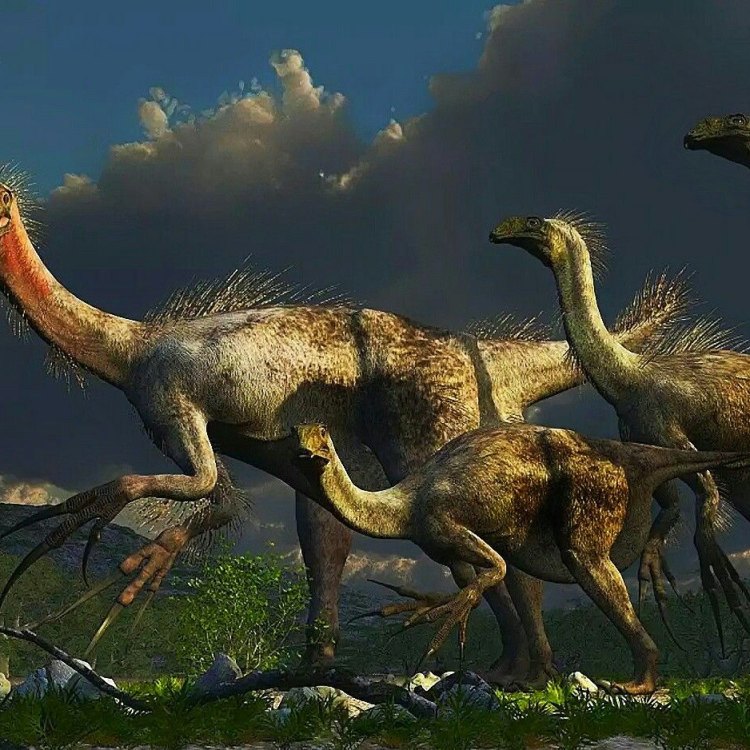
The Enigmatic Therizinosaurus: Unraveling the Mysteries of the Gobi Desert's Iconic Herbivore
Disclaimer: The content provided is for informational purposes only. We cannot guarantee the accuracy of the information on this page 100%. All information provided here may change without prior notice.

